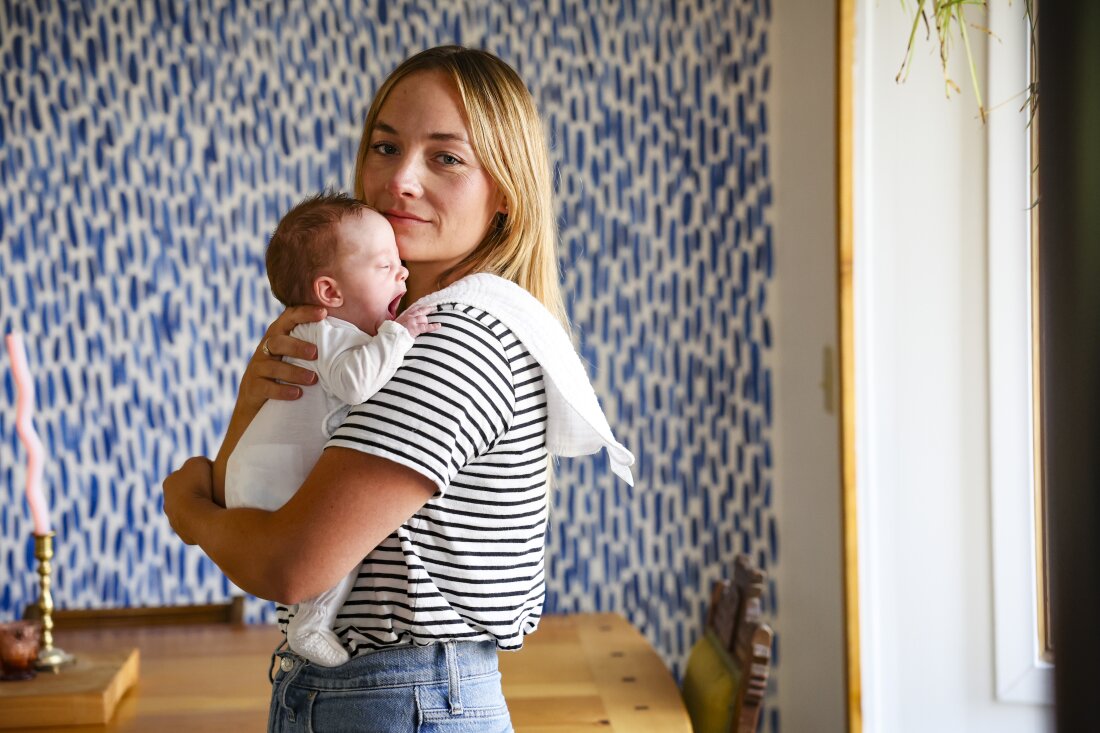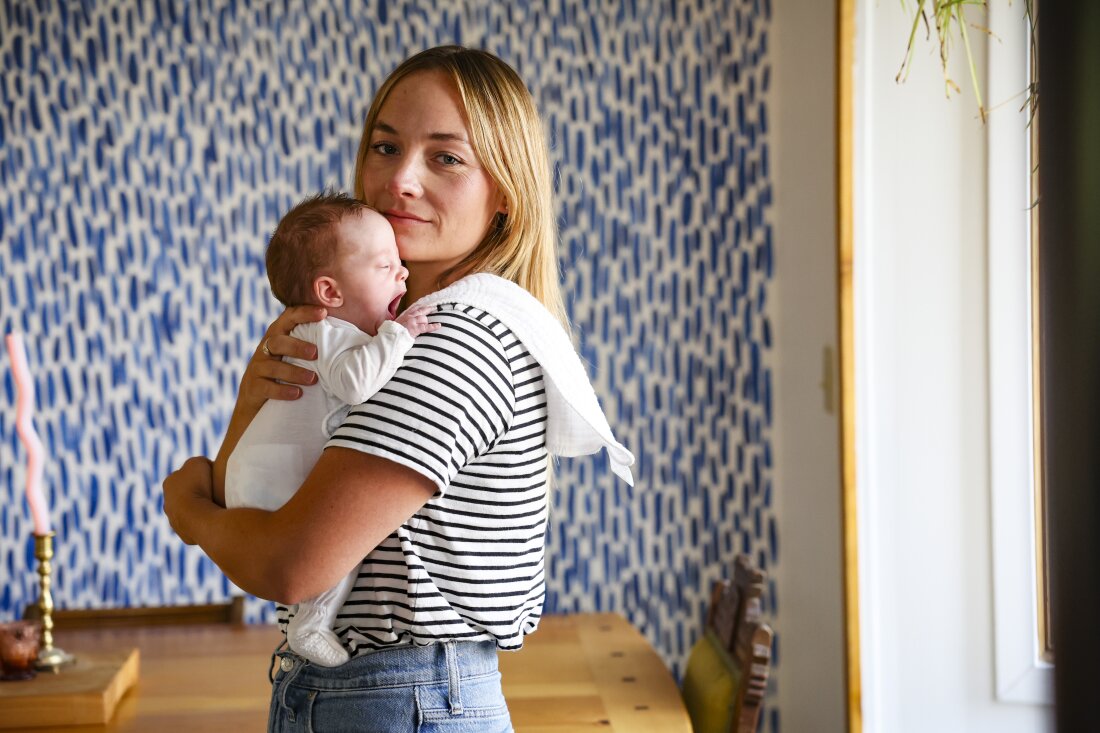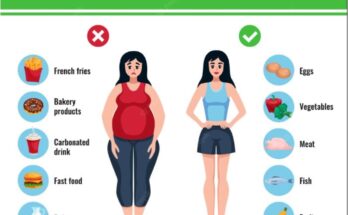
In August, Mary Collins and Rory’s daughter were both recovering after Collins had high blood pressure during pregnancy, which led to Rory’s premature delivery.
Thom Bridge for KFF Live News
hide description
toggle caption
Thom Bridge for KFF Live News
Sara McGinnis was nine months pregnant with her second child and something was wrong. His body was swollen. He was tired and dizzy.
Her husband, Bradley McGinnis, said she told her doctor and nurses about her symptoms and went to the emergency room when she got worse. But, Bradley said, what his wife was told in response was, “‘It’s summer and you’re pregnant.’ That bothers me.”
Two days later, Sara suffered a massive stroke followed by a fall. It happened on the way to the hospital, where he was headed again for a broken head.
Sara, from Kalispell, Montana, has never met her son, Owen, who survived the emergency birth and has round eyes and thick dark hair. He died a day after he was born.
Sara had eclampsia, a stroke during pregnancy caused by persistent high blood pressure, also known as hypertension. High blood pressure causes the heart to overwork, which can damage organs.
Sara passed away in 2018. Today, many pregnant women are diagnosed with dangerously high blood pressure, which can save their lives. Recent studies show rates of newly developed and chronic maternal high blood pressure have nearly doubled since 2007. Researchers say the spike in conditions may be due to screening. additional level-detecting.
But that is not the whole story. Data shows that the overall maternal mortality rate in the US is also rising, with high blood pressure one of the leading causes.
A new building
Medical experts are trying to stem this tide. In 2022, the American College of Obstetricians and Gynecologists lowered the threshold for whether doctors should treat pregnant and postpartum patients for high blood pressure. And federal agencies provide training in best practices for inspection and maintenance. State data shows that maternal deaths from high blood pressure have dropped in Alaska and West Virginia after the implementation of those guidelines. But applying those values to everyday care takes time, and hospitals are still working to incorporate the techniques that may have saved Sara’s life.

Mary Collins has no other risk factors for preeclampsia, such as being over 35 or being overweight. Doctors and researchers are not sure of all the reasons why high blood pressure during pregnancy is becoming more common.
Thom Bridge for KFF Live News
hide description
toggle caption
Thom Bridge for KFF Live News
In Montana, which last year became one of 35 states to implement federal patient safety guidelines, more than two-thirds of hospitals provided timely care to patients, Annie Glover said. , senior research scientist with the Montana Perinatal Quality Collaborative. Beginning in 2022, half of hospitals met that threshold.
“It takes time for a hospital to implement change,” Glover said.
“A natural stress test”
High blood pressure can damage a person’s eyes, lungs, kidneys, or heart, with long-term effects after pregnancy. Preeclampsia – persistent high blood pressure during pregnancy – can also cause heart disease. The problem can be caused by genetics or lifestyle: For example, being overweight makes people have high blood pressure. The same is true of aging, and many people have children later in life.
Black and indigenous people are more likely to have high blood pressure during pregnancy than the general population.
“Pregnancy is a natural stress test,” said Natalie Cameron, a physician and epidemiologist at Northwestern University’s Feinberg School of Medicine, who has studied the rise in high blood pressure diagnoses. “It reveals this danger that was there all along.”
But pregnant women who don’t fit the standard risk profile also get sick, and Cameron says more research is needed to understand why.
Mary Collins, 31, of Helena, Montana, developed high blood pressure while pregnant this year. In the middle of her pregnancy, Collins was walking and going to strength training classes. However, she felt lethargic and was gaining weight very quickly while her baby’s growth was slowing down.
Collins said she was diagnosed with preeclampsia after asking an obstetrician about her symptoms. He said that earlier, the doctor had said that everything was going well when he was checking the growth of his baby.
Collins said: “He took my blood pressure, did a physical exam, and looked at me. He was like, ‘Well, I’m going to take back what I said. I can easily confirm that you will be diagnosed with preeclampsia during this pregnancy, and you should purchase airline health insurance.’”
Of course, Collins was flown to Missoula, Montana, for the delivery and her daughter, Rory, was born two months earlier. The baby had to spend 45 days in the neonatal intensive care unit. Both Rory, now almost 3 months old, and Collins are recovering.
The usual treatment for preeclampsia is to deliver the baby. Medications can help prevent seizures and accelerate fetal growth to shorten pregnancy if the health of the mother or fetus requires early delivery. In rare cases, preeclampsia can develop immediately after delivery, a condition that researchers still do not fully understand.
Wanda Nicholson, chairwoman of the US National Institutes of Health, an independent group of experts on disease prevention, said consistent vigilance is needed during and after pregnancy to truly protect patients. Blood pressure “can change over a few days, or over a 24-hour period,” Nicholson said.
And the obvious signs aren’t always clear.
Such was the case with Emma Trotter. Days after giving birth to her first child in 2020 in San Francisco, she felt her heartbeat slow. Trotter said she called her doctor and nurse and they both told her she could go to the emergency room if she was worried but advised her it wasn’t necessary. So he stayed home.
In 2022, about four days after giving birth to her second child, her heart slowed again. At that time, the care team at her new home in Missoula checked her vitals. His blood pressure was so high that the nurse thought the machine’s motor had broken.
“‘You could have a stroke at any minute,'” Trotter recalled her midwife telling her before sending her to the hospital.
Trotter was due with her third child in September, and her doctors planned to send her home with the new baby on a blood pressure monitor.
Measuring the problem
More monitoring can help with more complex maternal health problems, said Stephanie Leonard, an epidemiologist at Stanford University School of Medicine who studies high blood pressure during pregnancy.
“Blood pressure is another area we can have an impact on,” he said. “It’s measurable. It’s treatable.”
More attention has been a long-term goal. In 2015, the federal Health Resources and Services Administration worked with the American College of Obstetricians and Gynecologists to develop best practices for making birth safe, including specific guidelines for diagnosing and treating high blood pressure. Last year the federal government raised funds for such efforts to expand the implementation of those guidelines.
“The biggest disparity in this area is about women’s voices not being heard,” said Carole Johnson, head of health resources.

Mary Collins and her daughter, Rory. Despite years of government efforts to make childbirth safer, hospitals are still struggling to match the diagnosis and treatment of preeclampsia with best practices.
Thom Bridge for KFF Live News
hide description
toggle caption
Thom Bridge for KFF Live News
The Montana Perinatal Quality Collaborative spent a year providing that hypertension training at hospitals across the state. In doing so, Melissa Wolf, head of women’s services at Bozeman Health, said her hospital system has learned that doctors using its treatment plan for high blood pressure during pregnancy are “hit or miss.” .” Even the way nurses checked the blood pressure of pregnant patients was different.
“We assumed that everyone knew how to take blood pressure,” Wolf said.
Now, Bozeman Health is tracking treatment with the goal of getting any pregnant woman with high blood pressure to the right care within an hour. There are leaflets on hospital walls and toilet doors showing the symptoms of preeclampsia. Patients are discharged with a list of red flags to watch for.
Katlin Tonkin is one of the nurses who trains Montana health care providers on how to make childbirth safe. She knows how important it is from experience: In 2018, Tonkin was diagnosed with severe preeclampsia at 36 weeks pregnant, weeks after she had developed symptoms. Her sudden delivery came too late and her son Dawson, who was not getting enough oxygen, died soon after he was born.
Tonkin has two more sons, both born healthy, and keeps photos of Dawson, taken during his short life, with the rest of his family.
“I wish I had known what I know now,” said Tonkin. “We have current evidence-based practices. We just need to make sure they’re there.”
KFF Health News is a national newsroom that produces in-depth journalism on life issues and is one of the main programs operating in KFF
#High #blood #pressure #kills #pregnancy #rise



